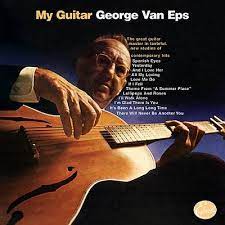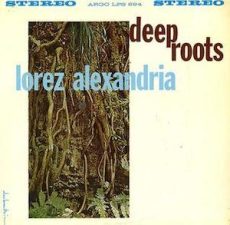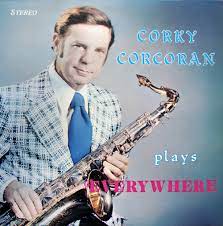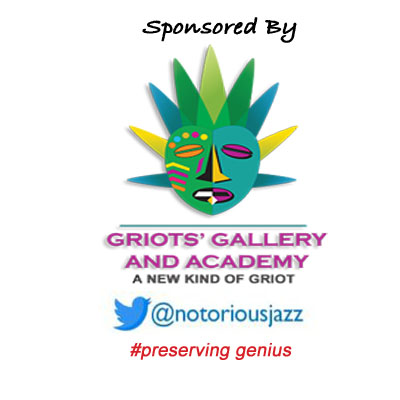
Daily Dose Of Jazz…
George Abel Van Eps was born on August 7, 1913 in Plainfield, New Jersey into a family of musicians. His mother was a classical pianist, his father was a ragtime banjoist and sound engineer and his three brothers were musicians. He began playing banjo at eleven years old but after hearing Eddie Lang on the radio, he devoted himself to guitar. By thirteen, in 1926, he was performing on the radio.
Through the middle of the 1930s, he played with Harry Reser, Smith Ballew, Freddy Martin, Benny Goodman, and Ray Noble. Van Eps moved to Los Angeles, California and spent most of his remaining career as a studio musician, playing on many commercials and movie soundtracks.
In the 1930s, he invented a model of guitar with another bass string added to the common six-string guitar. The seven-string guitar allowed him to play bass lines below his chord voicings, unlike the single-string style of Charlie Christian and Django Reinhardt. He called his technique “lap piano”, as it anticipated the fingerpicking style of country guitarists Chet Atkins and Merle Travis and inspired jazz guitarists Bucky Pizzarelli, John Pizzarelli, and Howard Alden to pick up the seven-string.
Dixieland had a following in Los Angeles during the 1940s and 1950s, and he played in groups led by Bob Crosby and Matty Matlock and appeared in the film Pete Kelly’s Blues. He played guitar on Frank Sinatra’s 1955 album. In The Wee Small Hours.
Playing guitar into his eighties, he built a career that lasted over sixty years. Swing and mainstream guitarist George Van Eps, who recorded eleven albums as a leader and thirty~two as a sideman, transitioned from pneumonia on November 29, 1998 in Newport Beach, California at the age of 85.
More Posts: guitar,history,instrumental,jazz,music

The Jazz Voyager
Setting down in Atlanta, Georgia after a fourteen and a half hour flight from Kyoto this Jazz Voyager is heading to friends for a shower and a lay down before heading out to indulge myself in a two stop night of jazz. My first stop is St. James Live for a little night music. Operated by husband-and-wife Ron and Evelyn St. James along with their daughter, Tiffany have established a warm, relaxing ambience for an extraordinary evening. With a menu ranging from tapas to sweet treats, salads and small bites, their culinary diversity will enchant and satisfy any palate. I’m looking at fish tacos and peach cobbler to hold me through the evening.
This week I’ll be in the audience enjoying The Baylor Project. A husband. A wife. An astonishing duo built on love, family, faith, culture and community. These are the things that power Jean and Marcus Baylor. This enticing collaboration is steeped in the heart and soul of jazz.
St. James Live is located in Camp Creek Village Townhomes at 3220 Butner Rd #240, 30331. More information can be obtained by calling 404-254-3561 or by visiting stjamesliveatl.com.
I’ll wrap up my evening with a late night hit with The Hightower Harper Hang at the Handle Bar at 476 Edgewood Avenue. More info at 404-600-2639. It’s a full night of jazz in the A where this Jazz Voyager hasn’t had the opportunity to see friends and musicians not seen or heard in a few years.
More Posts: adventure,club,genius,jazz,music,preserving,travel,trumpet,vocal

Daily Dose Of Jazz…
Vernel Anthony Fournier, was born July 30, 1928 in New Orleans, Louisiana, into a Creole family. He left college to join a big band led by King Kolax, however, after Kolax downsized to a quintet, he moved to Chicago, Illinois in 1948. There he played with Buster Bennett, Paul Bascomb and Teddy Wilson. As house drummer at the Bee Hive club on Chicago’s South Side from 1953 to 1955, he accompanied many visiting soloists, including Lester Young, Ben Webster, Sonny Stitt, J.J. Johnson, Earl Washington and Stan Getz.
From 1953 to 1956, Vernel worked many recording sessions with Al Smith, Red Holloway, Lefty Bates, and others. He joined Ahmad Jamal’s trio in 1957, along with bass player Israel Crosby, and remained with the group until 1962, appearing on a series of recordings on the Chess label. The best known of these, At the Pershing: But Not for Me (1958), became one of the best selling jazz records of all time, remaining on the Billboard jazz charts for over two years.
After leaving the Jamal trio, Fournier joined George Shearing for two years before rejoining Jamal briefly in 1965–66. He then took a long-running gig with a trio at a restaurant owned by Elijah Muhammad. Converting to Islam in 1975, he took the Muslim name of Amir Rushdan.
He worked with Nancy Wilson, Clifford Jordan, Billy Eckstine and Joe Williams, John Lewis and Barry Harris. He was a drumming teacher and worked at Barry Harris’s Jazz Cultural Theater, the New School, and the Mannes College of Music.
Suffering a stroke in 1994 left him unable to use his legs and confined him to a wheelchair. Although he was unable to play drums professionally, after his stroke, he continued his teaching activities. Never leading a recording date, Vernel recorded twenty-eight albums as a sideman with Lorez Alexandria, Gary Burton, Billy Eckstine, Benny Carter, Ahmad Jamal, Etta Jones, Sam Jones, Clifford Jordan, Houston Person, Jimmy Reed, George Shearing, and Frank Strozier.
Drummer Vernel Fournier, transitioned from a cerebral hemorrhage in Jackson, Mississippi on November 4, 2000.
More Posts: drums,history,instrumental,jazz,music

Daily Dose Of Jazz…
Corky Corcoran was born Gene Patrick Corcoran on July 28, 1924 in Tacoma, Washington and was considered a child prodigy. He began performing in bands at the age of 16.
Corcoran first played professionally in 1940 with Sonny Dunham, then joined Harry James’s ensemble from 1941 to 1947. Leaving James for a short time, Corky led his own ensemble and worked briefly in Tommy Dorsey’s band before rejoining James in 1949. He continued to work with James until 1957, playing concurrently with his own ensembles. Returning to James in 1962, he stayed almost up to his death.
Tenor saxophonist Corky Corcoran transitioned on October 3, 1979 in his hometown.
More Posts: bandleader,history,instrumental,jazz,music,saxophone

Daily Dose Of Jazz…
George “Geordie” Hormel was born on July 17, 1928 in Austin, Minnesota. He was the grandson of George A. Hormel, the founder of Hormel Foods. He claimed to have invented the corn dog when he was a teenager growing up in Minnesota.
In the 1950s and 1960s, Hormel composed music for numerous television shows including The Fugitive, Lassie, Naked City and The Adventures of Rin Tin Tin. He also sang as part of The Utility Muffin Research Kitchen Chorus on Frank Zappa’s triple album Joe’s Garage in 1979. He’s also done music for Capitol Records, most importantly the Hi-Q production music library.
In 1968 Geordie bought the Masonic Temple for $125,000 and founded a major independent studio, The Village Recording Studio, in Los Angeles, California of which he was proprietor until his death. It was one of, if not the first 24 track studio and Dolby Sound. He owned the Wrigley Mansion in Phoenix, Arizona and the Wrigley Mansion Club housed within it.
Geordie Hormel, who was a pianist, composer, record company owner, equipment dealer and always, ahead of his time,. transitioned on February 12, 2006 in Paradise Valley, Arizona at 77 years old.
More Posts: bandleader,history,instrumental,jazz,music,piano





